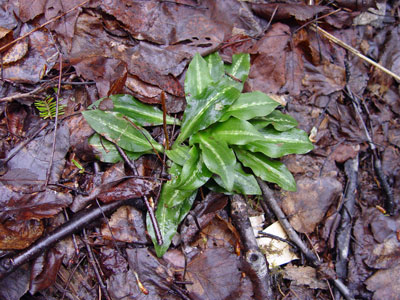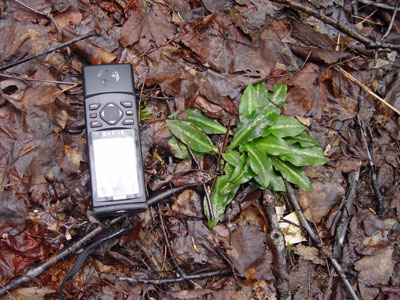DACF Home → Bureaus & Programs → Maine Natural Areas Program → Communities, Plants, and Animals → Rare Plants → Goodyera oblongifolia

Goodyera oblongifolia Raf.
Giant Rattlesnake-plantain
- State Rank: S1
- Global Rank: G5
- State Status: Endangered
Habitat: Dry coniferous or mixed woods. [Conifer forest (forest, upland)]
Range: Alaska, British Columbia to southwest Alberta, Saskatchewan, Ontario, Quebec to Maine, New Brunswick & Nova Scotia; California, Montana, Arizona, South Dakota; Great Lakes.
Aids to Identification: This orchid is closely related to our more common rattlesnake plantains (such as the checkered rattlesnake plantain, G. tesselata), and like them, grows from a basal rosette of leaves, sending up a flower stalk on which are borne small, creamy white flowers. It differs from other members of its genus in having the leaves larger (up to 10 cm long) and marked with only a broad whitish stripe up the middle, rather than the reticulated (net-like) leaf patterns of other Goodyeras.
Ecological characteristics: Goodyera oblongifolia differs from many of Maine's rare plants in that its habitat is not at all unusual, at least in appearance. The plant grows in spruce-fir woods of northern Maine, which in themselves are extensive. However, within this vast belt of ostensibly suitable habitat, the species has seldom been found, perhaps because it is at its southern range limit. Where it does occur, it may form large colonies, spreading by underground rhizomes.

Phenology: A perennial, leaves evergreen. Flowers late July - August, fruits mature fall. Fruit stalk and capsule often visible the next summer.
Family: Orchidaceae
Synonyms: Goodyera decipiens (Hook) Piper; Peramium deciepens (Hook) Piper.
Known Distribution in Maine: This rare plant has been documented from a total of 15 town(s) in the following county(ies): Aroostook.
Reason(s) for rarity: At southeastern edge of range, more abundant in western US and Canada. Populations are scattered and local in eastern US and Canada.
Conservation considerations: This plant has been known to disappear from an area following logging. Orchids are popular among some speciality gardeners, and populations of this species are vulnerable to unscrupulous or uneducated collectors. Plants dug from the wild usually do not survive; more importantly, removing these plants harms the natural population and may cause its eventual disappearance. Not known to have been successfully propagated, so any plants offered for sale have almost certainly been collected from the wild.
For more information, see the Native Plant Trust's Conservation Plan for Goodyera oblongifolia.